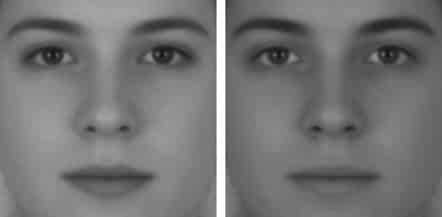Take a look at these two photos and consider which one is the Man and which is the Woman.
What did you decide?
Did you say the left appeared more feminine and the right more masculine? These were the findings of many people who took this test.
What were the factors that made you determine which was the Man and which was the Woman?
The Truth?
In actuality, this is a photo of the same person with different color contrasts in the eyes and mouth region in the two photos.
These photos were from a scientific study by the Harvard Psychologist Richard Russell. He studied the sex differences in the facial contrast in men and women. In these photos, he lightened the eyes and lips in the left photo and darkened the eyes and lips in the right photo. This was to prove his point that the degree of facial contrasts in a face contribute to the relative masculinity or femininity of a face.
Men and Women are Different!
It turns out that men in general have fewer differences in the contrast in their faces. To say it another way, men have less color differences throughout the different parts of their faces.
Women on the other hand have great differences in contrast in their faces or more differences in the color in different parts of their face. This is seen especially in the eye and mouth regions. Women have more natural color to their lips as compared to men.
Women intrinsically know what I’ve talked about before which is that people look at the mouth and eye area first when viewing another person. These are the two most powerful areas of the face for non-verbal communication with the outside world. This is why women intrinsically seek to highlight their eyes by wearing mascara and eye shadow and their lips by wearing lip liner and lipstick. By adding color to these areas, their faces are perceived by others as being more feminine.
Take a look at this woman with makeup on and without makeup on, which appears more feminine.
The increased color of her eyes and lips stimulate the non-verbal messages sent to our unconscious brains that assess beauty and feminine attractiveness and cause us to see the photo on the left as more feminine. This is another case of our subconscious brain being hard wired to find certain facial features and ratios beautiful. I discussed this concept of our subconscious brain before in my Blog: Perfect Proportions®: The Meaning of the Boxes
Facial Rejuvenation
As a specialist in Facial Rejuvenation, I like to concentrate on treatments that help optimize a person’s appearance in the eye and mouth region. I do this because I have studied how the brain sees another persons face. I want to help optimize those keys areas that make the biggest impact for my patients on the way that other people see them.
Although my procedures can help people with these two parts of the face, women especially can help themselves by wearing makeup that increases the contrast between their eye area and the surrounding skin and the lips and the surrounding skin. This will make those areas a greater contrast and therefore make a woman’s face more feminine in their appearance.
Sometimes though, makeup isn’t enough and that’s why patients come to see me. Understanding deep brain processes like the one demonstrated in example and the way our brains processes the faces of one another allow me to take advantage of this knowledge and get results which restore natural balance to the face. This leads to results which are powerful yet subtle. My patients in Florida and all over the country report that other people comment on how great they look after my help but can’t put there finger on exactly what changed, and it’s the secret my patients have the prerogative to keep to themselves or share with others as they like.
If you need help to Restore, Reveal and Reclaim your natural beauty, I’d be happy to be of service to you as you travel your journey towards facial rejuvenation.
References:
Russell Richard, 2009 “ A sex difference in facial contrast and its exaggeration by cosmetics” Perception. Volume 38, pages 1211 – 1219


